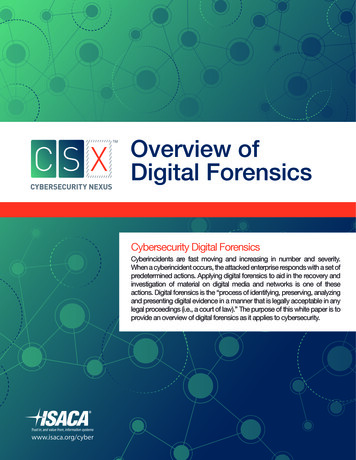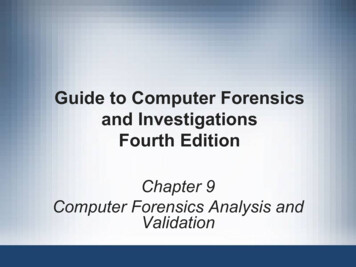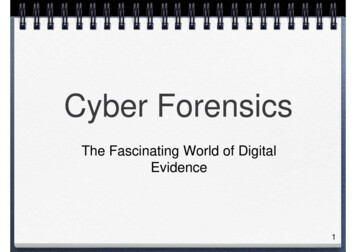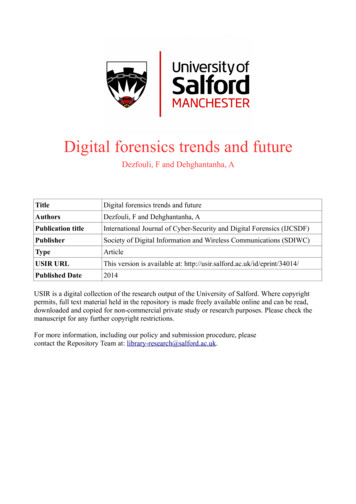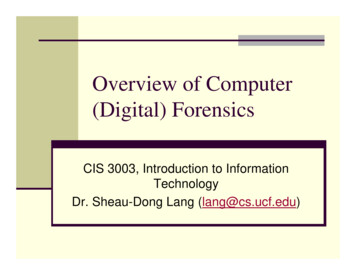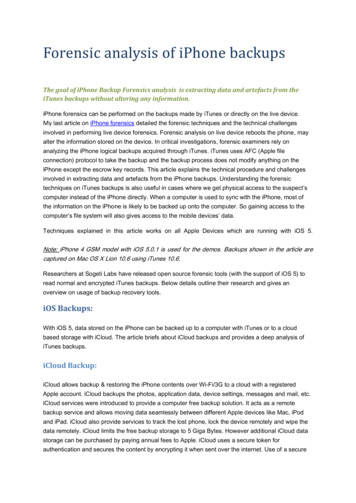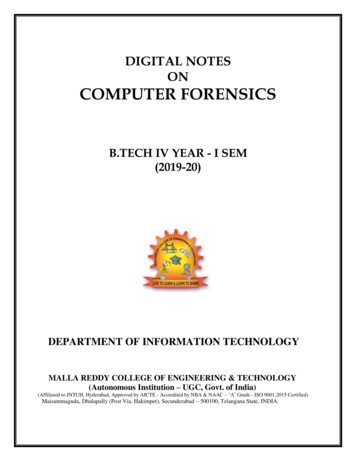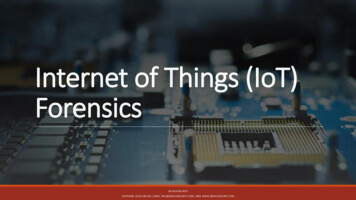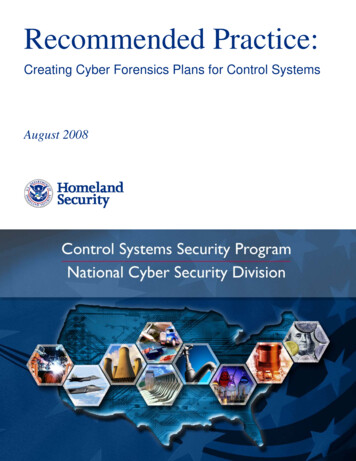
Transcription
Recommended Practice:Creating Cyber Forensics Plans for Control SystemsAugust 2008
Recommended Practice:Creating Cyber Forensics Plans for Control SystemsMark Fabro, Lofty Perch, Inc.Eric Cornelius, Idaho National LaboratoryAugust 2008DHS National Cyber Security DivisionControl Systems Security Program
ABSTRACTCyber forensics has been in the popular mainstream for some time, and hasmatured into an information-technology capability that is very common amongmodern information security programs. The goal of cyber forensics is to supportthe elements of troubleshooting, monitoring, recovery, and the protection ofsensitive data. Moreover, in the event of a crime being committed, cyberforensics is also the approach to collecting, analyzing, and archiving data asevidence in a court of law. Although scalable to many information technologydomains, especially modern corporate architectures, cyber forensics can bechallenging when being applied to non-traditional environments, which are notcomprised of current information technologies or are designed with technologiesthat do not provide adequate data storage or audit capabilities. In addition, furthercomplexity is introduced if the environments are designed using proprietarysolutions and protocols, thus limiting the ease of which modern forensic methodscan be utilized.The legacy nature and somewhat diverse or disparate component aspects ofcontrol systems environments can often prohibit the smooth translation ofmodern forensics analysis into the control systems domain. Compounded by awide variety of proprietary technologies and protocols, as well as critical systemtechnologies with no capability to store significant amounts of event information,the task of creating a ubiquitous and unified strategy for technical cyber forensicson a control systems device or computing resource is far from trivial. To date, nodirection regarding cyber forensics as it relates to control systems has beenproduced other than what might be privately available from commercial vendors.Current materials have been designed to support event recreation (event-based),and although important, these requirements do not always satisfy the needsassociated with incident response or forensics that are driven by cyber incidents.To address these issues and to accommodate for the diversity in both systemand architecture types, a framework based in recommended practices to addressforensics in the control systems domain is required. This framework must befully flexible to allow for deployment into any control systems environmentregardless of technologies used. Moreover, the framework and practices mustprovide for direction on the integration of modern network security technologieswith traditionally closed systems, the result being a true defense-in-depth strategyfor control systems architectures.This document takes the traditional concepts of cyber forensics and forensicsengineering and provides direction regarding augmentation for control systemsoperational environments. The goal is to provide guidance to the reader withspecifics relating to the complexity of cyber forensics for control systems,guidance to allow organizations to create a self-sustaining cyber forensicsprogram, and guidance to support the maintenance and evolution of suchprograms. As the current control systems cyber security community of interest iswithout any specific direction on how to proceed with forensics in controlsystems environments, this information product is intended to be a first step.Overall, this document provides the reader insight into some of the moreimportant issues that should be addressed in augmenting a cyber forensics plan soit can be effectively applied to a control systems environment.iii
EXECUTIVE SUMMARYCyber forensics has been in the popular mainstream for some time, and hasmatured into an information-technology capability that is common amongmodern information security programs. Although scalable to many informationtechnology domains, especially modern corporate architectures, developing acyber forensics program can be a challenging task when being applied to nontraditional environments, such as control systems. Modern IT networks, throughdata exchange mechanisms, data storage devices, and general computingcomponents provide a good foundation for creating a landscape used to supporteffective cyber forensics. However, modern control systems environments arenot easily configurable to accommodate forensics programs. Nonstandardprotocols, legacy architectures that can be several decades old, and irregular orextinct proprietary technologies can all combine to make the creation andoperation of a cyber forensics program anything but a smooth and easy process.This document takes the traditional concepts of cyber forensics and providesdirection regarding augmentation for control systems operational environments.The goal is to provide guidance to the reader with specifics relating to thecomplexity of cyber forensics for control systems, guidance to alloworganizations to create a self-sustaining cyber forensics program for their controlsystems environments, and guidance to support the maintenance and evolution ofsuch programs.This document is organized into three major sections:Section 1, Traditional Forensics and Challenges to Control SystemsSection 2, Creating a Cyber Forensics Program for Control SystemsEnvironmentsSection 3, Activating and Sustaining a Cyber Forensics Program.The document addresses the issues encountered in developing andmaintaining a cyber forensics plan for control systems environments. Thisrecommended practice supports forensic practitioners in creating a controlsystems forensics plan, and assumes evidentiary data collection and preservationusing forensic best practices. The goal of this recommended practice is not to reinvent proven methods, but to leverage them in the best possible way. As such,the material in this recommended practice provides users with the appropriatefoundation to allow these best practices to be effective in a control systemsdomain.iv
ACKNOWLEDGEMENTThis document was developed for the U.S. Department of HomelandSecurity (DHS) to provide guidance for creating a cyber forensics program for acontrol systems environment. The author team consisted of subject matterexpertise from Lofty Perch, Inc. (Mark Fabro) and Idaho National Laboratory(Eric Cornelius).For additional information or comments, please send inquires to the DHSControl Systems Security Program at cssp@dhs.gov.v
CONTENTSABSTRACT.iiiEXECUTIVE SUMMARY . ivACKNOWLEDGEMENT . vACRONYMS.viiiKEYWORDS. 1INTRODUCTION . 1AUDIENCE AND SCOPE . 3BACKGROUND . 51.TRADITIONAL FORENSICS AND CHALLENGES TO CONTROL SYSTEMS. 81.1 Challenges with Collection . 81.2 Challenges in Data Analysis . 121.3 Challenges in Reporting. 132.CREATING A CYBER FORENSICS PROGRAM FOR CONTROL SYSTEMSENVIRONMENTS. 142.1 Identifying System Environment and Uniqueness . 142.1.1 Modern/Common Technologies . 162.1.2 Modern/Proprietary Technologies . 192.1.3 Legacy/Proprietary Technologies . 212.2 Defining Environment Specific Requirements . 232.2.1 Impacts of Vendor Solutions on the Operating System . 242.2.2 Data mingling Consideration . 252.3 Identification and Collection of Data. 262.3.1 Reference Clock System . 262.3.2 Activity Logs and Transaction Logs . 272.3.3 Other Sources of Data . 332.3.4 General System Failures . 342.3.5 Real-time Forensics. 362.3.6 Device Integrity Monitoring . 362.3.7 Enhancing All-Source Logging and Auditing. 373.ACTIVATING AND SUSTAINING A CYBER FORENSICS PROGRAM. 393.1 Immediate Response and Incident Support. 394.REFERENCES . 42vi
FIGURESFigure 1. Control systems forensics domain and CSSP reference architecture. . 6Figure 2. Forensic plan components. . 7Figure 3. Non-persistence and uniqueness in data. . 11Figure 4. Example Modern/Common components. . 17Figure 5. Example Modern/Proprietary components. . 19Figure 6. Example Legacy/Proprietary components. 22TABLESTable 1. Modern/Common technologies and forensics compatibility. . 18Table 2. Modern/Proprietary technologies and forensics compatibility. . 20Table 3. Legacy/Proprietary technologies and forensics compatibility. . 23Table 4. Sample of possible artifacts and relevant forensic information. . 34Table 5. Roles matrix for incident response and forensics in control systems. . 40vii
ACRONYMSANSIAmerican National Standards InstituteCDcompact discCPUcentral processing unitCScontrol system2CS SATControl Systems Cyber Security Self Assessment ToolCSIMControl Systems Incident ManagerCSSPControl Systems Security ProgramCSSSControl Systems Security SpecialistDCSDistributed Control SystemsDHSDepartment of Homeland SecurityDVDDigital Video DiscDVD-ROMDVD Read Only MemoryEWSEngineering Work StationFWFirewallGPSglobal positioning systemHMIhuman-machine interfaceI/Oinput/outputIDSIntrusion Detection SystemIEDIntelligent Electronic DeviceIPSIntrusion Prevention SystemIRincident responseISAInstrumentation, Systems, and Automation Society (f. Instrument Society of America)ITinformation technologyNISTNational Institute of Standards and TechnologyNTPNetwork Time ProtocolOEMoriginal equipment manufacturerOSoperating systemPCSProcess Control SystemsPLCProgrammable Logic ControllerRTURemote Terminal UnitRWrewritableSCADASupervisory Control and Data AcquisitionSLAService/Security Level AgreementSNMPSimple Network Message ProtocolTCBtrusted computing baseviii
Recommended PracticeImproving Cyber Forensics Plans for Control SystemsKEYWORDSControl Systems, Forensics, Event Correlation, System Recovery, Incident Logging, IncidentAuditing, Cyber Security, Control Systems Networks, Incident ResponseINTRODUCTIONIn the control systems domain, where the overarching security principles of confidentiality, integrity,and availability often default to only availability and integrity (usually in that order of importance),technologies associated with system resiliency often displace security-specific activities. Currently,contemporary cyber security systems often need extensive aftermarket calibration to be truly effectiveinside control systems domains. Additionally, the overhead associated with fine-tuning these complexdevices (in the presence of unique and proprietary solutions) often contributes to their absence. Likesecurity technologies, cyber security activities and capabilities also need to be fine-tuned to accommodatefor the uniqueness and nuances associated with control systems.As a core component to incident response capabilities, cyber forensics provides for the collection,examination, analysis, and reporting of incident data. In most cases, the proper collection and analysis ofincident data supports investigations, uncovers illegal activities, and develops better-defined securitycountermeasures. Through the implementation of data exchange mechanisms, data storage devices, andsophisticated general computing components, modern networks provide a good foundation for creating alandscape used to support effective cyber forensics. Modern control systems environments, on the otherhand, are not as easily configured to accommodate forensics programs. Nonstandard protocols and legacyarchitectures, which can be several decades old, combined with irregular or extinct proprietarytechnologies can make the creation and operation of a cyber forensics program anything but a smooth andeasy process.Building on the common elements of standardized forensics processes, such as those related to thecollection, examination, analysis, and reporting of event data, this paper will provide the reader with afoundation to enhance and/or create a cyber forensics program for control systems environments. Due tothe diversity and disparate nature of technologies, platforms, and owner/operator deployments, thisdocument will provide the necessary elements to create a flexible framework, rather than those thatsupport specific technologies.This document is divided into three major sections: Section 1, Traditional Forensics and Challenges to Control Systems Section 2, Creating a Cyber Forensics Program for Control Systems Environments Section 3, Activating and Sustaining a Cyber Forensics Program.Section 1 addresses traditional forensics components and emphasizes the critical elements indeveloping a cyber forensics capability for control systems environments. Additionally, Section 1provides the reader with insight into the complexities and difficulties associated with building such acapability. These core components are then mapped to specific challenges in control systems to providethe reader with insight allowing for the development of a solution that can be customized to their specificenvironment.1
Section 2 addresses general components of the cyber forensic program and the elements that needdeveloping to ensure a viable and robust plan is usable by managers and users alike. In contrast totraditional cyber forensics plans, this section also includes requirements and suggestions related to controlsystems personnel, control systems operations, and business operations. This ensures the requirementsassociated with the forensics program are applicable to the particular control systems environment. Thissection introduces the reader to a cyber forensic framework that is tunable to any control systemsenvironment while still maintaining the fundamentals of an effective cyber forensic program.Section 3 addresses activation of the cyber forensics program for control systems, and providesinsights that allow organizations to sustain their program and ensure its applicability to the architecturefor which it was developed. In addition, this section highlights techniques for integrating the forensicscapability into incident response, as well as ensuring the forensics plan is part of the decision process as itrelates to making changes in the overall information architecture.2
AUDIENCE AND SCOPEThis document is for managers and security professionals responsible for developing, deploying, andimproving the cyber security posture of control systems domains. Although designed to be flexibleenough for system operators and engineers to read and use, this document’s intended use is by those thatare deploying cyber security incident response and/or forensics programs within control systemsenvironments. It is not designed to replace a sector-specific approach to creating a cyber forensicsprogram, but rather provide guidance as it relates to control systems specific issues. It may be found mostappropriate by either those that have experience in deploying cyber forensics programs in moderninformation technology (IT) domains and who are beginning to address the issues related to deployingcyber forensic strategies for control systems architectures, or by control systems network professionalsrequiring guidance on creating a cyber forensics capability for their systems. The scope of the material isnot technically demanding and can help provide a foundation for creating or augmenting existinginformation resource protection and recovery initiatives.Although it may be required that a forensic examination of an incident on a control systems device isintended to ascertain if criminal activity has occurred, the methodologies used for the correct collection ofdigital data (although fairly ubiquitous across most domains) require modifications to accommodate forcontrol systems uniqueness. As such, the scope of this recommended practice will be limited to thoseconcepts that can impede the smooth preparation and development of a cyber forensics program forcontrol systems. Additionally, this document provides insight as to what the Owner/Operator communitycan do to prepare proactively for a forensics investigation in support of an incident response capability.Although this document discusses content regarding collection, handling, and analysis of control systemsdata, material as it relates to the detailed methodologies involved in collection, handling, and reporting ofevidentiary data will be excluded from this document, and it is assumed that evidentiary data will becollected and preserved using forensic best practices. The goal of this recommended practice is not to reinvent proven methods, but to leverage them in the best possible way. As such, the material in thisdocument will provide users with the appropriate foundation to allow for implementing itsrecommendations effectively in a control systems domain.In the interest of brevity, and assuming the general readership will have experience with some ITsecurity aspects, any standards for cyber security that are discussed are presented at a non-technical level(i.e., high level). This document does not try to provide justification as to why an organization wouldwant to develop a forensics program, but rather it provides guidance to those that wish to augment aproven IT forensic process for their control systems domain. However, the authors recognize that withinseveral critical infrastructure sectors, such as electricity (generation and transmission), cyber incidentresponse and forensics plans are required.a Furthermore, the authors stress that the citation of anyparticular document is not to sway the reader’s opinion in favor of the practices of any one sector, but todemonstrate the activities of that sector regarding cyber forensics.The current landscape of terminologies associated with critical infrastructure and control systemsoperations can lead to unforeseen complexity. In this document, the term “control systems” will refer totechnologies that are often defined as Supervisory Control and Data Acquisition (SCADA), ProcessControl Systems (PCS), Distributed Control Systems (DCS), or any combination thereof. The authors arenot intending to discredit or avoid recognizing the often-clear differentiators in these environments. It isintended that the nomenclature used with the recommendations herein is broad enough to be applied inany of these domains.a. For example NERC CIP cyber security guidelines required by the FERC Order 706 (see References)3
To highlight some of the more important points in cyber forensics for control systems, these icons areoccasionally used.This symbol is used to identify ancillary informational points that may be ofparticular interest to readers developing a cyber forensics program for control systems.This symbol is used to identify cautionary points that should be considered carefullywhen developing a cyber forensics program for control systems.4
BACKGROUNDWhile the field of cyber forensics has been in the popular mainstream for some time, cyber forensicsas applied to control systems is immature. With increasing computational capability and interoperabilitycoming to previously isolated networks, the necessity for cyber forensics in control systems is becomingquite clear. In addition, the qualitative differences between corporate networks and control systemsnetworks often highlight why security countermeasures are not easily deployable in control systems.Control systems have considerable requirements related to (in order of priority) availability, dataintegrity, and confidentiality. As opposed to corporate domains, where the priorities reverse, cybersecurity activities in control systems networks require accommodating for systems that cannot readily betaken offline, may not be quickly modernized, and may not be able to facilitate adequate logging andaudit functions. These elements are, of course, vital to a forensic program’s success. Although allshortcomings that may be present in control systems (from a cyber security perspective) may beovercome by budget allocations and spending, many organizations find the cost of incorporating cybersecurity functionality into control systems technology quite high. Thus, being able to create effectivesecurity programs (such as forensics) for control systems involves reusing existing methodologies andpractices, such as those designed for corporate domains. The requirement then becomes understandingwhat changes or augmentations to these proven capabilities are required to allow applicability to controlsystems networks.The term “forensics” often relates to “the post-incident collection and analysis of data obtained fromdevices.” Due to the unique and uncommon nature of control systems technologies, there is ofteninadequate information collected from these countermeasures following a cyber attack or incident. Insome cases, where the owner/operators are cognizant of these shortcomings in commercial securityproducts, tailored signatures and detection capabilities specific to control systems operations are createdand appended to the security devices. However, because the nature of control systems operations canrequire deterministic and real-time data exchanges, it is often the case that these enhancements eitherprove useless or inhibit the actual productivity of the systems. Additionally, these enhancements are oftendeployed as a defensive activity only and are not extended to support any forensic function in theorganization.Figure 1 is a basic control systems security reference architectureb that illustrates the concept of thecontrol systems forensics domain in relation to traditional IT domains. This reference architecture simplyprovides a basic framework for illustrative purposes, and is not representative of any architecture otherthan a notional one.b. See Control Systems Cyber Security: Defense in Depth 0in%20Depth%20Strategies.pdf.5
Figure 1. Control systems forensics domain and CSSP reference architecture.cThere are additional challenges with forensics analysis for control systems. The field devices that areused within control systems architectures, perhaps the terminus of a cyber incident resulting in physicalconsequences, often have no inherent capability for detailed logging. Furthermore, it has been found thaton devices where extensive logging is supported the feature is often disabled, or the devices lacksufficient capacity to store enough data to allow analysts to meet forensics requirements.d Lastly, thediversity of the control systems technologies in use today also poses significant problems.Owner/operator staff often does not have the skill sets to collect, examine, or analyze command andcontrol traffic. Instead, owners of the control systems (and devices) rely upon vendor/integrator staff forsupport. This in itself can precipitate delays in incident analysis and resolution, as understanding ofdetailed device operations and logging capabilities are often left until it is too late or completed “after-thefact.” Although systems can be configured to alarm operators in a timely fashion, the interpretation of thedata and the correlation to an incident remain dependent upon the end user’s technical skill level. Indeed,countermeasures can be instituted for any and all of these issues, but the cost associated with making suchchanges to the controls systems operational domain is generally too high in both time and testing, andrequires significant amount of time and effort by the owner/operator.c. The diagram is notional in nature and does not account for all possible architectures. As an example, it is not uncommon formodems to be connected directly into applications servers as well as PLCs, especially in legacy environments.d. Readers should be aware that in some sectors, such as energy/electric, specific audit requirements demand that event data isstored at some point in the system. Although this data storage may not be fully viable to an incident, investigation, transaction,and event data are available in some form within the information domain.6
Overall, the challenges impacting effective forensics in control systems can be summarized as: Many traditional device and control systems technologies do not provide for the collection ofeffective data that could be used for post-incident security analysis.e Those systems that do have suchcapability are often in operation mode without such capability active. Current cyber-forensic methodologies are not always fully extensible to traditional control systemsarchitectures. For the architectures that do use modern cyber-centric security procedures and technologies(Firewalls [FW], Intrusion Detection Systems [IDS], Intrusion Prevention Systems, [IPS], etc.), theunification of forensic data collected by these systems cannot always be effectively correlated withdevice and control systems logging data. Post-incident analysis is often dependent on vendor involvement, and any proactive understanding ofdevice logging is often not required by the end user or incorporated into a defense-in-depth strategy.To address these issues at the appropriate level, guidance for developing a control systems forensicprogram is required. This guidance must be fully flexible to allow for deployment into any controlsystems environment regardless of technologies used. Moreover, the guidance must provide for directionon the integration of modern network security technologies with traditionally closed systems, the resultbeing a true defense-in-depth strategy for control systems architectures. This strategy will be acombination of technical, managerial, and operational issues that provide for a structured approach that,when the aggregate is finished, gives a flexible but strong security posture.This document introduces some of themore essential cyber security activities thatare important for the development of acontrol systems cyber forensic program.Figure 2 illustrates the major componentsthat will contribute to helping create anorganizational cyber forensics plan forcontrol systems domain.Figure 2. Forensic plan components.e. Requirements from NERC demand that event data is stored in some fashion, usually for the purpose of event recreation. Thedata may not help in a forensics investigation, but readers should be aware that such requirements do exist.7
1.TRADITIONAL FORENSICS AND CHALLENGESTO CONTROL SYSTEMSTo understand some of the issues associated with creating a cyber forensics program for controlsystems, it is pertinent to review the core components of standard cyber forensics programs and discussthem in terms of the irregularities associated with control systems. Generally, the definit
maintaining a cyber forensics plan for control systems environments. This recommended practice supports forensic practitioners in creating a control systems forensics plan, and assumes evidentiary data collection and preservation using forensic best pract
